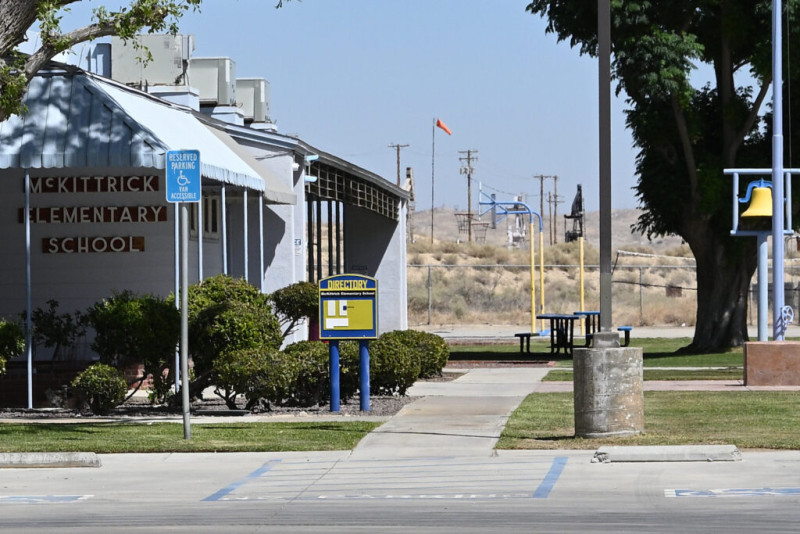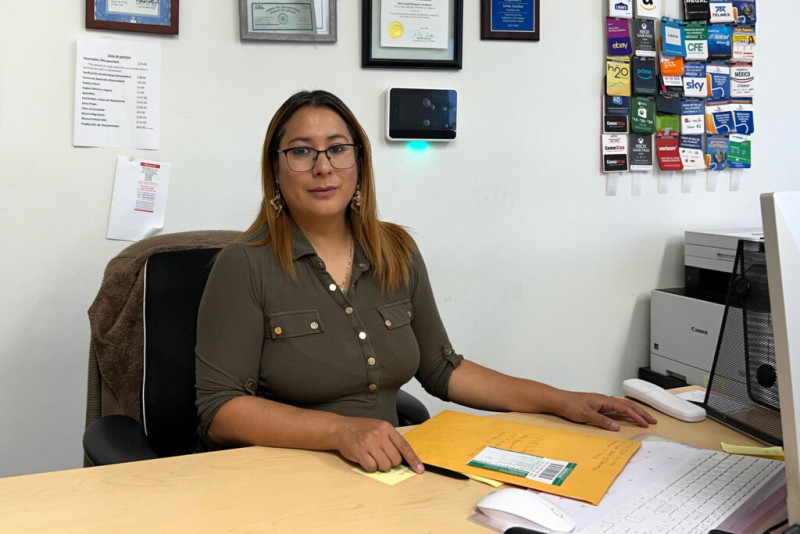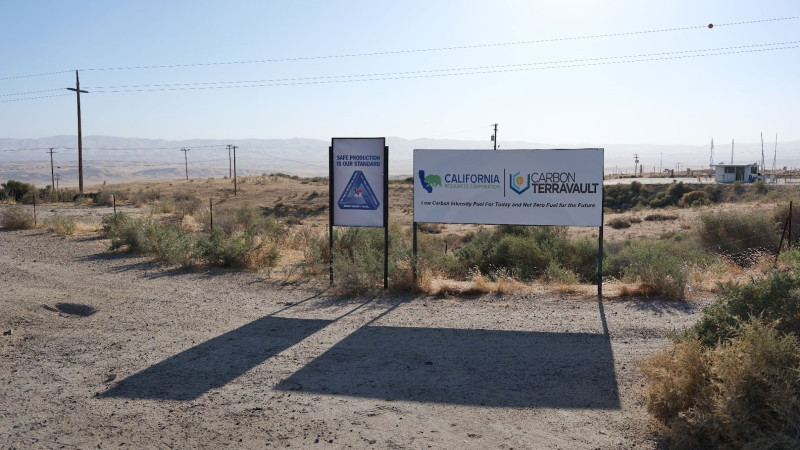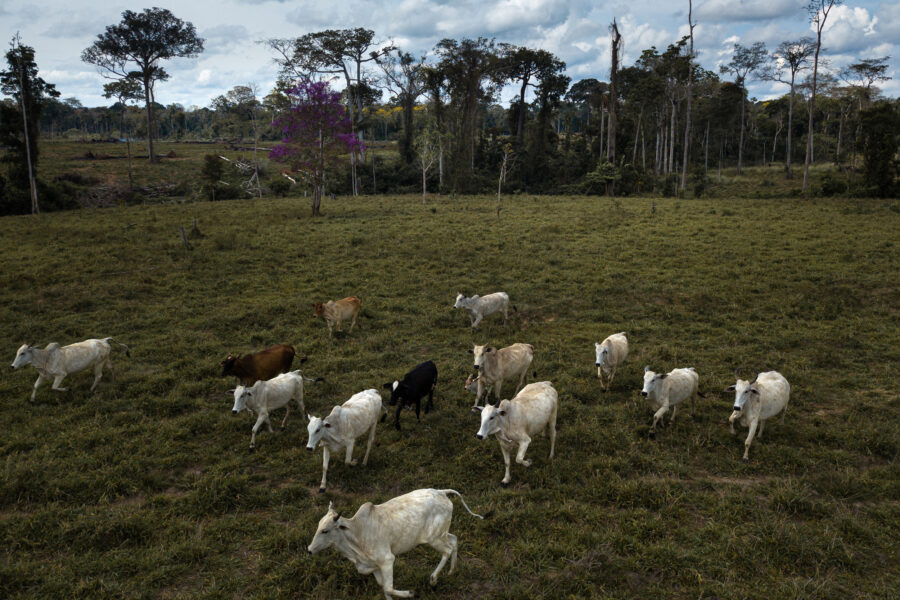Proposals to Build California’s First Carbon Storage Facilities Face a Key Test
Proposals to build California’s first carbon storage facilities are facing key tests in the coming weeks, beginning with a vote by the Kern County Planning Commission Thursday night.
The commission will decide whether to approve plans submitted by two oil companies, Aera Energy and California Resources Corporation (CRC), to build and operate the facilities. The companies want to inject planet-warming carbon dioxide deep beneath active oil fields.
CRC’s project, called Carbon TerraVault 1, is farther along; it has already received a conditional permit from the Environmental Protection Agency to inject carbon. In July, CRC and Aera merged. CRC, now California’s leading oil and gas producer, has said the deal strengthens its position in the nascent carbon management industry.
Explore the latest news about what’s at stake for the climate during this election season.
The projects have been the subject of heated debate in the heart of California’s oil country. County leaders see carbon removal and storage as a way to generate tax revenue as the state plans to phase out oil drilling over the next two decades, while helping to combat climate change. But some residents, along with environmental advocates and local community groups, say the projects come with too many risks and too much uncertainty.
“We’re kind of out in the middle of nowhere, so our town seems like it can get affected by it,” said Sonia Sanchez, a resident of Buttonwillow, a tiny agricultural community located near the proposed site of the TerraVault. Sanchez works as a notary in the predominantly Latino town, and has helped organize local opposition to the TerraVault proposal.
Her fear stems in part from an incident that happened in 2020, when a carbon dioxide pipeline ruptured near the small Mississippi town of Satartia, sending more than 40 people to the hospital. At very high concentrations, the gas is an asphyxiant.
“From what we’ve seen in Mississippi, it was extremely harmful,” Sanchez said. “We have our children here, so that’s one of the things that is concerning.”
“I don’t want to sound selfish, but honestly, I’m worried about my family,” she added.
But others in nearby oil towns have embraced the industry. The mayor of Taft said he had no problem sending his grandchildren to a school located about 5 miles from a pipeline proposed for CRC’s project.
“Seventy-nine students in that school, three of ‘em are my grandsons,” Dave Noerr told a crowd during an informational workshop hosted by the county earlier this year. “Would I approve a project just because I thought it was good for the city? Absolutely not.”


McKittrick Elementary School in Kern County sits within five miles of a proposed carbon dioxide pipeline and injection well. Credit: Joshua Yeager/KVPR
KVPR and Inside Climate News reviewed more than a thousand pages of reports that the county has prepared to assess CRC’s project and its impacts, along with related public comments. Reporters also spoke with more than a dozen experts with knowledge of various aspects of carbon removal and storage.
Taken together, the reports, comments and analysis provide a clearer picture of the uncertainties surrounding projects that could set a precedent for California’s carbon management industry. Experts say that whether the potential benefits to the climate and the economy outweigh the risks to residents, including the possibility of leaks and increased seismicity, will depend on the extensive engineering and monitoring needed to ensure that the facility is safe.
While some environmental advocates and community groups say they are wary of the oil industry’s poor health and safety record, the county appears confident that it can mitigate risks. Planning Commission staff have recommended approval for both Aera and CRC’s proposals.
‘Proof of Concept’
California’s San Joaquin Basin, where Kern County is located, is one of a few dozen basins in the United States that is well-suited geologically for carbon storage. The area was once an inland sea. Over tens of millions of years, the bowl-like valley gradually filled with sediment. Slowly, silt and rocks covered marine life, which decomposed into the oil and gas that has made Kern one of the nation’s most prolific fossil fuel producers.
A downturn in oil production in recent decades has pushed the county to consider other options to support its economy. Those same rock formations are ideal for trapping carbon dioxide, said Preston Jordan, a geologist at Lawrence Berkeley National Laboratory. Regions with a legacy of oil and gas production have an advantage when it comes to carbon storage, he said, because “there’s essentially geologic proof of concept.”
There are just a few dedicated carbon storage projects operating in the U.S., but geologic experts including Jordan say the science around storing the planet-warming greenhouse gas underground is well understood. That’s largely because of a practice called “enhanced oil recovery,” in which oil companies inject carbon dioxide underground to help push more oil to the surface. The practice has been in use for decades; nationwide, there are more than 130 projects using enhanced oil recovery, pushing nearly two billion cubic feet of carbon dioxide underground, according to a consulting company that tracks the industry.
But California passed a law in 2022 prohibiting the use of the technique using carbon sourced from carbon capture projects. According to the legislation, the state’s carbon capture ambitions are meant to “facilitate the transition to a carbon-neutral society and not to facilitate continued dependence upon fossil fuel production.”
Permanently storing carbon dioxide is technologically similar to enhanced oil recovery, according to oil industry and carbon storage experts. “Even if it hasn’t been implemented largely at scale yet, we still generally understand how it works,” said Rohan Dighe, a carbon storage analyst at energy consultancy Wood Mackenzie.
“We’re going to inject a bunch of high pressure carbon dioxide and just hope that these wells aren’t leaking.”
Carbon dioxide is injected underground as a liquid. It then spreads upward and sideways, sometimes over thousands of acres, into tiny spaces amid the subterranean rock layers. To prevent leaks, an injection site needs several layers of impenetrable rock that will act as a “cap” to keep the expanding plume from reaching the surface.
But some environmental advocates are concerned that the large number of holes drilled through the rocks that underlie Kern County could allow carbon dioxide to escape. The Elk Hills oil field, where CRC plans to inject carbon, is perforated with thousands of wells, according to the county’s most recent environmental impact report
“We’re going to inject a bunch of high pressure carbon dioxide and just hope that these wells aren’t leaking,” Daniel Ress, a senior attorney at the Center for Race, Poverty and the Environment, said in an interview.
Dominic DiGiulio, a retired EPA geoscientist who analyzed CRC’s project as a consultant for environmental groups, said in public comments submitted to the county that hundreds of wells perforate the storage reservoirs proposed for the TerraVault site. The large number of holes creates leakage risks due to the high pressure at which carbon dioxide is injected, DiGiulio wrote.
CRC plans to plug some of these wells as part of the project, but those plans leave up to 40 wells unaccounted for, he noted.
CRC did not provide specific responses to questions on this comment and others, but referred KVPR and Inside Climate News to the environmental impact report prepared by the county. “The Kern County Planning and Natural Resources Department has prepared an extensive Environmental Impact Report in order to thoroughly evaluate all of the substantive environmental topics involved with the project,” CRC spokesperson Richard Venn said in an email. “The County has provided thorough responses—with extensive supporting information—regarding each of the environmental questions submitted during the Environmental Impact Report comment period.”
In a response to public comments about CRC’s proposed project, the county noted that Kern County has held “oil and gas deposits for millions of years at pressures at or above the project’s CO2 storage pressure,” and though the site has many wells, no leakage has been recorded during past injection into these wells. (DiGiulio said there is no evidence that leakage monitoring happened.)
In an email to KVPR and Inside Climate News, Kern County Planning Director Lorelei Oviatt wrote that the county was not commenting further on CRC’s proposal until after “final consideration by the Board of Supervisors.”
‘The Largest Hazard’
Carbon injection can also cause earthquakes, a phenomenon called “induced seismicity.”
“Induced seismicity has been, in my opinion, the largest hazard associated with CO2 injection,” said Joern Kaven, a research geophysicist at the U.S. Geological Survey.
Kaven has monitored such seismicity for a decade at a carbon storage test facility in Illinois. The largest earthquake during that time was a mere 1.26 in magnitude, a small temblor that wouldn’t be felt at the surface. But Kaven said “there is an inherent risk” that injecting liquid underground may cause earthquakes. In Oklahoma, and Ohio—in areas with no prior knowledge of geologic faults—injection of oil wastewater, a process similar to carbon injection, has induced earthquakes at magnitudes greater than 3.0, shaking residents.
The potential impacts of injection on natural faults are important to consider in areas where earthquakes are not uncommon, like California, said Kaven. The San Andreas fault is located within 15 miles of CRC’s proposed project. And though the project does not overlap with active surface faults, earthquakes deeper in the earth’s crust have occurred in the project area and in the county, according to the county’s environmental assessment.
Whether projects induce earthquakes depends on the location of active faults and the pressure they’re under. Significant changes in underground pressure can aggravate faults. Historically, extraction of oil and gas has reduced pressure in the oil field where CRC’s project would be located, injecting carbon dioxide would increase it, according to geologic experts.
In its most recent environmental impact report on the project, the county said that planning for the project included well logs, seismic data and pressure data gathered over four decades of development at the site. Increased pressure due to carbon dioxide injection, the report said, would not exceed the underground pressure of the reservoir before oil and gas extraction began.
But determining which faults will rupture and when is an area of active research. According to Kaven, “some of the ingredients” that contribute to induced seismicity are not currently measurable. “We have an incomplete knowledge of where the large faults are that are capable of hosting significant magnitude earthquakes. And even if we knew where they were, we cannot measure the stress that’s on them,” he said.
Kaven—excited about the potential for these types of projects—said evaluating them involves weighing and then minimizing the risks, including those from climate change. “Are we willing to accept a few earthquakes in places that might be damaging—hopefully not deadly—but thereby reduce the risks to health and safety by having less emissions of greenhouse gasses?” he said. “That’s certainly something to consider.”
‘A Worst-Case Event’
For some residents, like Sanchez, the underground injection wells are less of a worry than the pipelines that would carry carbon dioxide to them. CRC’s TerraVault project would include about 11 miles of pipelines within the facility’s boundaries. More than 500 elementary students currently attend schools located within about 6 miles of one proposed pipeline.

Experts say carbon dioxide pipeline ruptures are rare, but that could change as companies build more pipelines in the coming decades. Both scientists and oil industry executives agree that pipeline buildout will be critical to the success of carbon storage facilities. Those facilities hope to generate revenue by charging fees and collecting tax incentives for storing carbon dioxide underground. But they may not be located near plants that produce carbon dioxide and will need pipelines to deliver it to them.
To protect residents in the event of a rupture or a leak like the one in Mississippi, environmental advocates want carbon storage projects to be located far from communities. The TerraVault project would be situated on an oil field with relatively few people living nearby, but some buildings—including 13 schools—sit within 10 miles of wells or proposed pipelines.
Kern County’s environmental impact report on the TerraVault proposal says that in a “worst-case event for a catastrophic failure” carbon dioxide would travel up to 867 feet from the project location. Beyond that distance, the county’s report says, “the worst-case CO2 plume poses no risk of health or safety impacts.”
Richard Kuprewicz, a consultant who has overseen pipeline construction and operations for several oil and gas companies, says the county’s analysis “probably isn’t credible.” The distance that carbon dioxide could travel depends on a variety of factors, such as topography and the amount of CO2 released, but Kuprewicz, who has reviewed the county’s environmental analysis of the project, expects a large leak would travel miles rather than hundreds of feet.
“CO2 is heavier than air, so it’s going to go a long way,” Kuprewicz said. “If it’s on a hill, then it’s going to flow downhill like water.”
The injection wells are located at a higher elevation than nearby towns, such as Buttonwillow, according to the county’s environmental assessment.
Federal regulations require pipelines carrying hazardous material to be located more than 50 feet from homes or gathering places. For CRC’s project, Kern County will require injection wells to be located more than 4,000 feet from facilities such as schools.
Kuprewicz said establishing a setback-distance standard for pipelines carrying carbon dioxide is challenging, because local conditions vary. “Offset distances, even well intended, aren’t going to be effective I think,” he said in an email.
In the wake of the Mississippi incident, the federal government has begun updating regulations for carbon dioxide carrying pipelines, a process that Kuprewicz expects will take years to complete. A 2022 California law prohibits the buildout of new pipelines until new rules are in place. In the meantime, state regulations allow companies to build pipelines within the boundaries of carbon storage facilities.
Trust Issues
Some environmental and community advocates also have deep misgivings about letting the fossil fuel industry—which has a strong financial interest in continuing oil extraction—lead efforts meant to combat climate change.
“I live right where all these oil wells are,” wrote Lori Pesante, who added that she had “seen the manipulative practices these oil companies engage in. It is INSANE to grant them ANY ability to engage in projects of this magnitude.”
In addition to generating revenue for storing carbon, these projects are eligible for lucrative state subsidies and federal tax credits. And some firms—including California Resources Corporation—have plans to continue drilling while pursuing carbon storage projects.
“California needs oil,” said Francisco Leon, the company’s CEO in an August earnings call, “and we will be here to provide it.”

Oil companies are behind the four carbon storage projects in Kern County that the U.S. Environmental Protection Agency is currently evaluating. (The agency, which regulates injection wells in most states, is examining seven other projects in California and 49 nationwide.)
But according to many experts, oil and gas companies are among those most suited to undertake such projects.
Steve Whittaker, a vice president at Vault 44.01, which develops carbon storage projects, said that building such facilities requires a sizable commitment. Companies have to invest hundreds of thousands of dollars and a lot of time to gather data for their permit applications.
“Anybody who is going to undertake this has to be aware that to write a permit takes many, many months of work, and an awful lot of information,” he said.
If Kern’s Planning Commission approves the projects, the county’s Board of Supervisors is expected to vote on them in October. The EPA will also need to approve the proposals.
Environmental advocates as well as the oil and carbon management industries are closely watching the votes in Kern. If approved, CRC’s project would be among the first wave of commercial carbon storage facilities in the United States.
“Carbon removal approaches, I think when ideally implemented, can increase the pace and scale of ambition on climate action,” said Daniel Sanchez, who directs the Carbon Removal Lab at University of California, Berkeley, and the principal scientist at Carbon Direct, a carbon management firm. “It’s a challenge to the industry to get this right the first time, I think it’s a challenge for regulators to get this right the first time.”
“We all need to be really close to scrutinizing it,” he added.
This story is part of a series, After Oil: California’s Big Bet, which examines the impact of the state’s decision to phase out oil drilling on its largest oil-producing county. This project is a collaboration between KVPR, Inside Climate News, Investigative Editing Corps, and Report for America.
About This Story
Perhaps you noticed: This story, like all the news we publish, is free to read. That’s because Inside Climate News is a 501c3 nonprofit organization. We do not charge a subscription fee, lock our news behind a paywall, or clutter our website with ads. We make our news on climate and the environment freely available to you and anyone who wants it.
That’s not all. We also share our news for free with scores of other media organizations around the country. Many of them can’t afford to do environmental journalism of their own. We’ve built bureaus from coast to coast to report local stories, collaborate with local newsrooms and co-publish articles so that this vital work is shared as widely as possible.
Two of us launched ICN in 2007. Six years later we earned a Pulitzer Prize for National Reporting, and now we run the oldest and largest dedicated climate newsroom in the nation. We tell the story in all its complexity. We hold polluters accountable. We expose environmental injustice. We debunk misinformation. We scrutinize solutions and inspire action.
Donations from readers like you fund every aspect of what we do. If you don’t already, will you support our ongoing work, our reporting on the biggest crisis facing our planet, and help us reach even more readers in more places?
Please take a moment to make a tax-deductible donation. Every one of them makes a difference.
Thank you,
David Sassoon
Founder and Publisher
Vernon Loeb
Executive Editor
Share this article
Disclaimer: The copyright of this article belongs to the original author. Reposting this article is solely for the purpose of information dissemination and does not constitute any investment advice. If there is any infringement, please contact us immediately. We will make corrections or deletions as necessary. Thank you.








